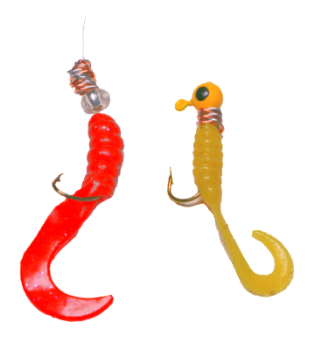So much for the 2015/16 ice-fishing season in Southern Alberta, a few die-hard anglers are still putting in an effort but I’m cautious of bad ice, it could be fine in the A.M. but go to cubes in the P.M. It seems that the entire season has been a season of bad ice and non-co-operative fish, everyone we talked to has had a tough year.
No caption needed here but.. "Stay safe out there"
Rachel and I got out a few times this winter but did not fish much. It was more fun giving out samples and talking to anglers for us than fishing. We would approach a party of anglers then give one sample to one person and rig it for them to make sure they were using it correctly. Then we would leave and return in a few hours to see how they were getting along. Our greatest thrill this season was the response everyone had using our Electrons. They all asked for more samples. Most folks caught fish and the ones that did not said the Attractors brought them in no problem; they just could not catch them.
Hans about to release a nice Walleye
This Rattlesnake Lake angler in Alberta we only know as Hans was about to release his 7th Walleye when we returned to see how he liked using the Electrons. He had killed his limit of 50 cm Walleye and had a few nice perch on the ice.
Hans admitted that he does not catch anything and will never fish without the Electron again. He was so excited and thankful that we had some to sell him.
We learned a lot this winter regarding salts dissolved in the water, total dissolved solids or TDS seem to disappear as winter drags on. Lakes that were 150 to 200 PPM have dropped to less than 100 PPM; some lakes like Ghost Lake went as low as 50 PPM. We keep track of this because it affects conductivity in the water.
The lower the TDS the less conductivity means the more Electrons you use.
We had no idea that this decrease in TDS was so dramatic in late winter although Jason Fraser, a Calgary area biologist, warned us of this.
Here are the hottest Electron rigs per species
Whitefish
The rig that out fished anything else this winter for Whitefish is the Fresh Water 1 or 2 Low TDS a glass bead (supplied) on a short shank beak hook and a single maggot. This rig clobbered Whites everywhere in Southern Alberta. We suspect it will work for Whites anywhere.
The Electron is so small you can cast it with a fly rod suspended from a strike indicator or a small bobber cast from a lite spinning rod.
Walleye
The rig that Walleye preferred is the Electron Fresh Water 2 or 3, low TDS, a glass bead in clear or yellow (supplied), a short shank hook with a minnow or a scented minnow by Berkley Gulp, Trigger X etc.
A bill-less crank bait with the Electron and a glass bead can be unbeatable.
Perch, Crappy and Pan fish
Perch can’t resist the Electron Fresh Water 1, 2 or 3 series, a glass bead and a hook with maggots, minnow, scented grubs and minnows.
- For very low TDS use the Fresh Water 3 Low TDS
- For a TDS over 200 PPM use the Fresh Water 1 Low TDS.
Tube jigs work great, only use the tube, thread it on the line then thread the appropriate Electron, a glass bead and a short shank hook. Pull it all into the tube (bait is optional). This rig can be used in open water suspended from a bobber or jigged over the weeds.
Fish shallow (3 to 6 feet) at first ice and deeper (50 to 60 feet) at last ice.
See below for photo of small white tube jig.
Northern Pike
Dead lining is Canada's all-time favorite method to catch Pike, a species that quickly responds to the Electron Fish Attractor. The all-time favorite rig for pike is a 6 to 10 inch nylon coated steel leader or equivalent threaded through the anus of a bait fish coming out the mouth. Slide an Electron on the leader into the mouth of the bait.
I seem to have my best luck when the bait lays on the bottom.
Trout
Use an Electron Fresh Water 1, 2 or 3 Low TDS, a glass bead, a short shank hook with maggots, scented grubs or minnows. Pull this into the tube.
Small spoon baits with the Electron slid on the line isolated with a glass bead can be jigged with great success for larger trout of all species.
Do not use any terminal tackle, keep it moving covering all depths.
All Char species respond to tapping the spoon on the bottom.
Photo byJason Fraser
This beautiful Lake Trout was caught in extremely LOW TDS conditions
using 5 Fresh Water 3's in a tube jig.
Tight Lines
Rick Crozier










